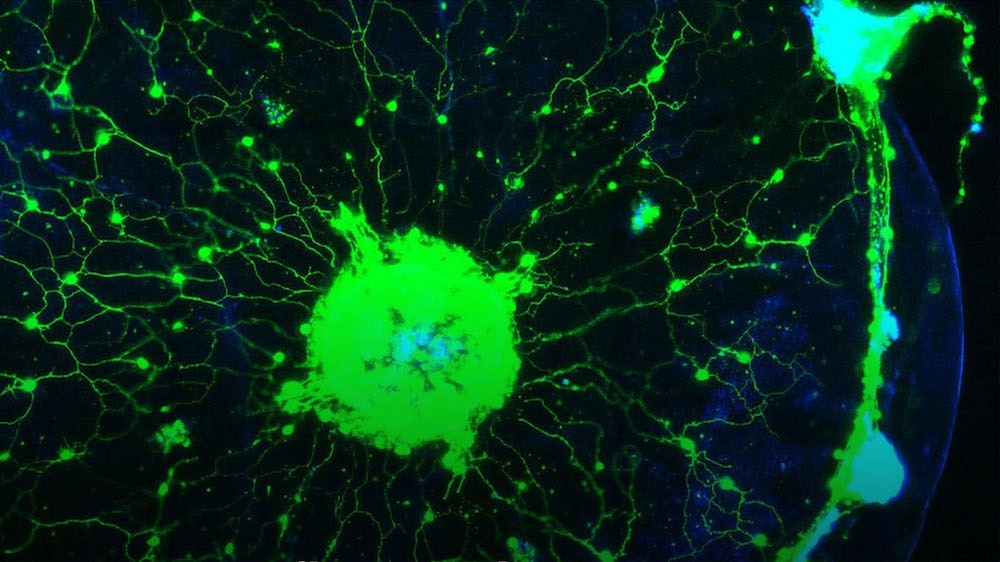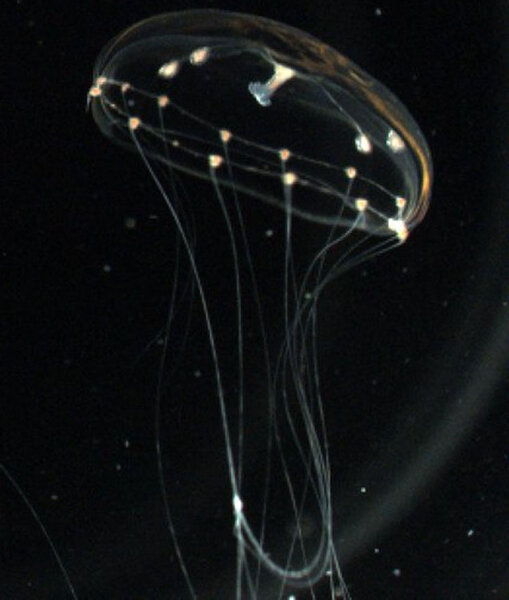Create a free profile to get unlimited access to exclusive videos, sweepstakes, and more!
Glowing jellyfish brains could help us read human minds
We might learn more about what goes on inside the human brain from the glowing neurons of jellyfish.

Could we really learn more about what goes on in the human brain from a jellyfish, a cnidarian more distantly related to us than even worms?
Clytia hemisphaerica is a tiny jellyfish that only grows to one centimeter in diameter (sans tentacles). Though many species are bioluminescent, since this one isn’t, it had to be genetically engineered to glow in the dark so a team of CalTech researchers would be able to literally read its mind. While reading its thoughts — what kind of thoughts do jellyfish even have? — was not exactly possible, they were able to read what was going on in its bizarre brain.
Mind-reading in this sense is more about understanding the actual circuits of brain cells that are in charge of everything from motor functions, such as swimming or feeding, to reactions when a predator ventures too close. This is why biologist Brady Weissbourd wanted to find out what was going on in the jellyfish brain and how that can be applied to more complex systems of neurons like our own. He led a study recently published in Cell.
“Jellyfish have incredible abilities to heal and regenerate, and are constantly integrating newborn neurons into their nervous system,” Weissbourd told SYFY WIRE. “How they evolved this is speculative, maybe their decentralized, modular nervous system is more robust and enables those processes.”
To read the minds, or rather the glow-in-the-dark brains, of the jellyfish, Weissbourd and his team focused on how the animals ate. They were expecting something of a disorganized scattering of neural activity, but what was actually revealed by the glowing neurons was that they are much more organized than previously assumed. Something creepy they found out about a jellyfish’s decentralized nervous system is that one part can keep on doing whatever it was doing even if it is removed. For example, a disembodied mouth is still able to keep chewing.
It sounds like something out of a monster movie. However, even though the nervous system of a jellyfish is decentralized, groups of neurons activate together at the same time, and this activity was visible when they flashed more light. These neurons run from the edges of the animal to its mouth. When a jellyfish eats, they are simultaneously activated and its body folds inward so it can shove the food it just caught with its tentacles into its mouth. Imagine that a creature with only 10,000 neurons is capable of this compared to our 100 billion.
“Our data suggests that jellyfish neurons produce a wide range of neuropeptides, with subpopulations of neurons often having their own specific peptide,” Weissbourd said. “We studied a subpopulation defined by one of these neuropeptides called RFamide.”
There is actually an entire group of RFamide neuropeptides that all have the same chemical sequence. They are receptors that are involved in many behavioral, sensory, automatic, and neuroendocrine functions, not just in jellyfish but also in mammals, including humans. Closer observation showed that this particular RFamide isn’t zapped between neurons to communicate with each other. It is actually thought to be released where it is needed so it can act directly on that muscle of the jellyfish to make it contract and fold inwards, at least in the eating process.
Jellyfish are usually not what come to mind when you think of lab animals, but Weissbourd thinks that they could be the new frontier of research because you can literally see right through them. Green fluorescent protein (GFP) came from these invertebrates and was a biological breakthrough because it can be used to light up embryos and fetuses so they can be studied as they develop. Because jellyfish are simple animals that are easy to manipulate, how and when their neurons fire could ultimately give us more insight into the mysteries of our own.
“If we can deeply understand these processes using simpler nervous systems, we will learn something about how to eventually understand a human brain as well as make predictions about what we should be looking for,” Weissbourd said.
It's wild to think that someone watching the neurons of a jellyfish flash on and off like arcade lights could be reading human minds.



























